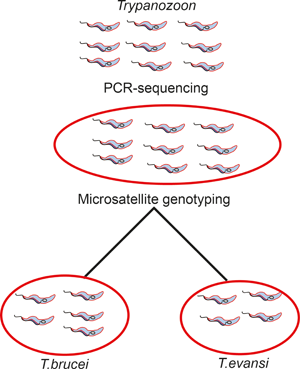Published online by Cambridge University Press: 28 October 2021

The prevalence rates of trypanosomes, including those that require cyclical transmission by tsetse flies, are widely distributed in Africa. Trypanosoma brucei and Trypanosoma congolense are actively maintained in regions where there are no tsetse flies although at low frequencies. Whether this could be due to an independent evolutionary origin or multiple introduction of trypanosomes due to continuous movement of livestock between tsetse-free and -infested areas is not known. Thus, the aim of the study was to carry out microsatellite genotyping to explore intra-specific genetic diversity between T. (Trypanozoon), T. congolense and Trypanosoma vivax from the two regions: tsetse infested and tsetse free. Microsatellite genotyping showed geographical origin-based structuring among T. (Trypanozoon) isolates. There was a clear separation between isolates from the two regions signalling the potential of microsatellite markers as diagnostic markers for T. brucei and Trypanosoma evansi isolates. Trypanosoma vivax isolates also clustered largely based on the sampling location with a significant differentiation between the two locations. However, our results revealed that T. congolense isolates from Northern Kenya are not genetically separated from those from Coastal Kenya. Therefore, these isolates are likely introduced in the region through animal movement. Our results demonstrate the occurrence of both genetic connectivity as well as independent evolutionary origin, depending on the trypanosome species between the two ecologies.